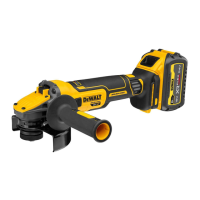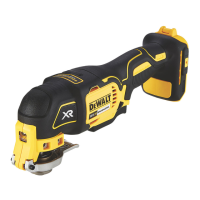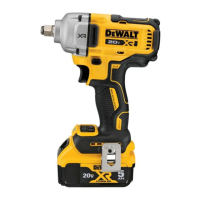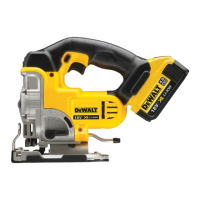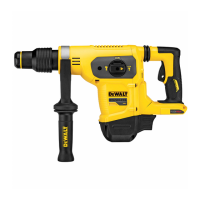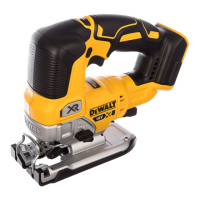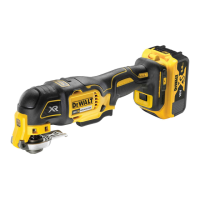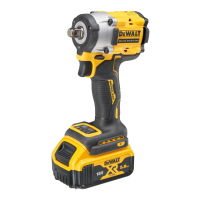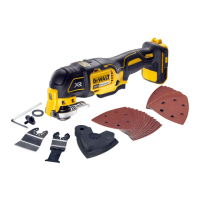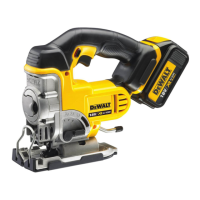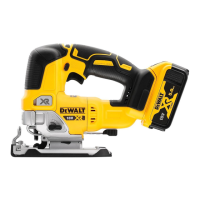56
ENGLISH
Surface Grinding, Sanding and Wire
Brushing (Fig. L)
CAUTION: Always use the correct guard per the
instructions in thismanual.
To perform work on the surface of a workpiece:
1. Allow the tool to reach full speed before touching the tool
to the worksurface.
2. Apply minimum pressure to the work surface, allowing
the tool to operate at high speed. Material removal rate is
greatest when the tool operates at highspeed.
3. Maintain an appropriate angle between the tool and work
surface. Refer to the chart according to particularfunction.
Function Angle
Grinding 20˚‑30˚
Sanding with Flap Disc 5˚‑10˚
Sanding with Backing Pad 5˚‑15˚
Wire Brushing 5˚‑10˚
4. Maintain contact between the edge of the wheel and the
worksurface.
- If grinding, sanding with flap discs, or wire brushing,
move the tool continuously in a forward and back
motion to avoid creating gouges in the worksurface.
- If sanding with a backing pad, move the tool constantly
in a straight line to prevent burning and swirling of
worksurface.
Spindle Lock (Fig. A)
The spindle lock button
4
is provided to prevent the spindle
from rotating when installing or removing wheels. Operate
the spindle lock only when the tool is turned off, the battery is
removed and has come to a completestop.
NOTICE: To reduce the risk of damage to the tool, do
not engage the spindle lock while the tool is operating.
Damage to the tool will result and attached accessory
may spin off possibly resulting ininjury.
To engage the lock, depress the spindle lock button and rotate
the spindle until you are unable to rotate the spindlefurther.
Variable Speed Dial (Fig. A)
The variable speed dial
12
offers added tool control and
enables the tool to be used at optimum conditions to suit the
accessory andmaterial.
• Turn the variable speed dial
12
to the desired level. Turn
the dial upward for higher speed and downward for
lowerspeed.
Paddle Switch (Fig.A)
DCG416VS
1. To turn the tool on, push the lock-off lever
3
toward the
back of the tool, then depress the paddle switch
1
. The tool
will run while the switch isdepressed.
2. Turn the tool off by releasing the paddleswitch.
Switches
CAUTION: Hold the auxiliary handle and body of the
tool firmly to maintain control of the tool at start up and
during use and until the wheel or accessory stops rotating.
Make sure the wheel has come to a complete stop be fore
laying the tooldown.
NOTE: To reduce unexpected tool movement, do not switch
the tool on or off while under load conditions. Allow the grinder
to run up to full speed before touching the work surface. Lift the
tool from the surface before turning the tool off. Allow the tool
to stop rotating before putting itdown.
Slider Switch (Fig.A)
DCG409VS
WARNING: Before connecting the tool to a power supply,
be sure the slider switch is in the off position. Ensure the
slider switch is in the off position after any interruption
in power supply to the tool, such as the activation of a
ground fault interrupter, throwing of a circuit breaker,
accidental unplugging, or power failure. If the slider switch
is locked on when the power is connected, the tool will
startunexpectedly.
To start the tool, slide the ON/OFF slider switch
2
toward
the front of the tool. To stop the tool, release the ON/OFF
sliderswitch.
For continuous operation, slide the switch toward the front of
the tool and press the forward part of the switch inward. To stop
the tool while operating in continuous mode, press the rear part
of the slider switch andrelease.
Proper Hand Position (Fig. K)
WARNING: To reduce the risk of serious personal injury,
ALWAYS use proper hand position as shown.
WARNING: To reduce the risk of serious personal injury,
ALWAYS hold securely in anticipation of a suddenreaction.
Proper hand position requires one hand on the main handle
26
and the other hand on the auxilliary handle
6
, as shown in Fig.K.
OPERATION
Instructions for Use
WARNING: Always observe the safety instructions and
applicableregulations.
WARNING: To reduce the risk of serious personal
injury, turn tool off and disconnect battery pack
before making any adjustments or removing/
installing attachments or accessories. An accidental
start-up can causeinjury.
backing pad for cracks, tear or excess wear, wire brush for
loose or cracked wires. If power tool or accessory is dropped,
inspect for damage or install an undamaged accessory. After
inspecting and installing an accessory, position yourself and
bystanders away from the plane of the rotating accessory
and run the power tool at maximum no-load speed for one
minute. Damaged accessories will normally break apart
during this testtime.
